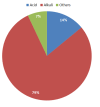Corrosive oesophageal injuries: a preventable menace
- PMID: 23898360
- PMCID: PMC3725316
- DOI: 10.11604/pamj.2013.15.11.2495
Corrosive oesophageal injuries: a preventable menace
Abstract
Introduction: Potentially catastrophic presentations and lifelong complications resulting from corrosive ingestions in humans is one of the most challenging situations encountered in clinical medical practice. This study reviewed pattern, mechanisms and associated socio-medical challenges with ingestion of corrosive agents as seen in a tertiary health institution in South-western Nigeria.
Methods: A retrospective review of all patients that were managed for corrosive ingestion at Ladoke Akintola University of Technology Teaching Hospital, Osogbo, Osun State, Nigeria, over a seven year period.
Results: A total of 28 patients M:F: 1.6:1. There were 7 children and 21 adults. Majority (78.6%) of the patients ingested alkaline substances. Accidental ingestion occurred in 28.6% while 71.4% resulted from deliberate self harm especially among adults (66.7%). Almost two thirds (64.3%) of the patients presented after 48hrs of ingestion. Patients who presented early were managed conservatively. Most patients (64.3%) who presented late had nutritional and fluid rehabilitation. Two patients died from oesophageal perforation and resulting septicaemia. Psychiatric evaluation revealed that seven adults (25%) had psychotic illness while (42.9%) of the patients developed oesophageal strictures. Short segment strictures were managed with oesophageal dilatation with good outcome while long and multiple segment strictures were referred to cardiothoracic surgeons for management.
Conclusion: Corrosive oesophageal injuries remain a prevalent and preventable condition in the developing countries. Preventive strategies should include regulation and packaging of corrosive substances, organization of psychiatric services, and education of the population on corrosive ingestion.
Keywords: Corrosive injuries; Nigeria; accidental ingestion; caustic ingestion; esophageal stricture; mechanisms; prevention; psychiatric disorders; self harm.
Figures
Similar articles
-
Presentation and management outcome of childhood corrosive oesophageal injury in Benin City.Afr J Paediatr Surg. 2020 Jul-Dec;17(3 & 4):74-78. doi: 10.4103/ajps.AJPS_90_10. Afr J Paediatr Surg. 2020. PMID: 33342838 Free PMC article.
-
Acute esophageal injury and strictures following corrosive ingestions in a 27year cohort.Am J Emerg Med. 2017 Mar;35(3):488-492. doi: 10.1016/j.ajem.2016.12.002. Epub 2016 Dec 6. Am J Emerg Med. 2017. PMID: 27955797
-
Chemical injuries of the oesophagus: aetiopathological issues in Nigeria.J Cardiothorac Surg. 2009 Oct 16;4:56. doi: 10.1186/1749-8090-4-56. J Cardiothorac Surg. 2009. PMID: 19835579 Free PMC article.
-
A retrospective analysis of ingestion of caustic substances by children. Ten-year statistics in Galicia.Eur J Pediatr. 1997 May;156(5):410-4. doi: 10.1007/s004310050627. Eur J Pediatr. 1997. PMID: 9177989 Review.
-
Oesophageal corrosive injuries in children: a forgotten social and health challenge in developing countries.Bull World Health Organ. 2009 Dec;87(12):950-4. doi: 10.2471/BLT.08.058065. Bull World Health Organ. 2009. PMID: 20454486 Free PMC article. Review.
Cited by
-
A systematic review of burn injuries in low- and middle-income countries: Epidemiology in the WHO-defined African Region.Afr J Emerg Med. 2017 Mar;7(1):30-37. doi: 10.1016/j.afjem.2017.01.006. Epub 2017 Jan 28. Afr J Emerg Med. 2017. PMID: 30456103 Free PMC article. Review.
-
Caustic soda ingestion in children under-5 years presenting for fluoroscopic examinations in an Academic Hospital in Ghana.BMC Res Notes. 2015 Nov 17;8:684. doi: 10.1186/s13104-015-1629-3. BMC Res Notes. 2015. PMID: 26576563 Free PMC article.
-
Caustic ingestion injury of the upper aerodigestive tract in adults.Ann R Coll Surg Engl. 2015 May;97(4):304-7. doi: 10.1308/003588415X14181254789286. Ann R Coll Surg Engl. 2015. PMID: 26263940 Free PMC article.
-
Presentation and management outcome of childhood corrosive oesophageal injury in Benin City.Afr J Paediatr Surg. 2020 Jul-Dec;17(3 & 4):74-78. doi: 10.4103/ajps.AJPS_90_10. Afr J Paediatr Surg. 2020. PMID: 33342838 Free PMC article.
-
Quality of life in patients of corrosive esophageal stricture treated with endoscopic dilatation.JGH Open. 2021 Jan 12;5(2):301-306. doi: 10.1002/jgh3.12490. eCollection 2021 Feb. JGH Open. 2021. PMID: 33553671 Free PMC article.
References
-
- Tsung-Yi Chen, Sheung-Fat Ko, Jiin-Haur Chuang, Hsin-Wei Kuo, Mao-Meng Tiao. Predictors of Esophageal Stricture in Children with Unintentional Ingestion of Caustic Agents. Chang Gung Med J. 2003;26(4):233–238. - PubMed
-
- Catalina Lionte, Laurentiu Sorodoc, Ovidiu Rusalim Petri, Victorita Sorodoc. Unusual Presentation and Complication of Caustic Ingestion, Case Report. J Gastrointestin Liver Dis. 2007;16(1):109–112. - PubMed
-
- Ogunleye AO, Nwaorgu GB, Grandawa H. Corrosive oesophagitis in Nigeria: clinical spectrums and implications. Trop Doct. 2002;32(2):78–80. - PubMed
MeSH terms
Substances
LinkOut - more resources
Full Text Sources
Other Literature Sources

